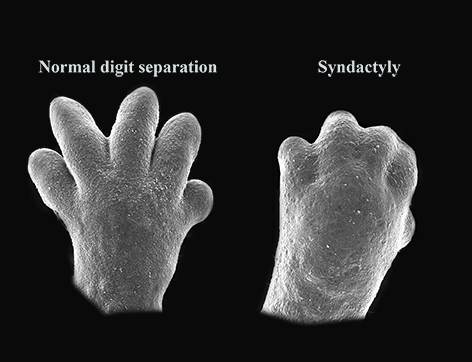One of the most common limb malformation in humans, syndactyly was thought to be caused by insufficient removal of the connective tissue between the developing digits. In a study, published today in Developmental Cell, researchers reveal that the overlying skin also plays an active role and is required for sculpting of the digits, and that a layer of non-adhesive cells on the skin’s surface is required to prevent the fusion of adjacent digits.
“Our study identifies epidermal developmental processes required for digit separation that expand beyond the insufficient removal of connective tissue. These additional factors play an integral role in syndactyly and may be implicated in other complex syndromes, including Van der Woude syndrome,” said Ghaidaa Kashgari, PhD, a post-doctoral researcher in the UCI School of Medicine Department of Biological Chemistry, and first author on the paper titled, “Epithelial migration and non-adhesive periderm are required for digit separation during mammalian development.”
Van der Woude syndrome is characterized by cleft lip and/or cleft palate. In addition, seven to eight percent of Van der Woude patients have limb defects, most commonly soft tissue syndactyly which suggests there is a shared developmental mechanism in oral-clefting and digit separation.
“Our research shows that the GRHL3 gene is required for normal digit separation. When this gene is mutated, it can affect the function of the non-adhesive cells on the skin’s surface causing conditions such as Van der Woude syndrome associated with syndactyly as well as cleft lip and palate,” said Bogi Andersen, MD, a professor of medicine and biological chemistry in the UCI School of Medicine, and director of the UCI Skin Biology Resource-based Center.
This work was supported by the National Institutes of Health, the Irving Weinstein Foundation, National Science Foundation, the Simons Foundation, and Research to Prevent Blindness, Inc.
About the UCI School of Medicine
Each year, the UCI School of Medicine educates more than 400 medical students, and nearly 150 doctoral and master’s students. More than 700 residents and fellows are trained at UCI Medical Center and affiliated institutions. The School of Medicine offers an MD; a dual MD/PhD medical scientist training program; and PhDs and master’s degrees in anatomy and neurobiology, biomedical sciences, genetic counseling, epidemiology, environmental health sciences, pathology, pharmacology, physiology and biophysics, and translational sciences. Medical students also may pursue an MD/MBA, an MD/master’s in public health, or an MD/master’s degree through one of three mission-based programs: the Health Education to Advance Leaders in Integrative Medicine (HEAL-IM), the Leadership Education to Advance Diversity-African, Black and Caribbean (LEAD-ABC), and the Program in Medical Education for the Latino Community (PRIME-LC). The UCI School of Medicine is accredited by the Liaison Committee on Medical Accreditation and ranks among the top 50 nationwide for research. For more information, visit som.uci.edu.
Original post https://alertarticles.info


